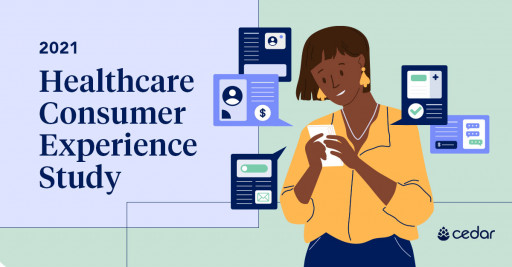NEW YORK, Dec. 07, 2021 (GLOBE NEWSWIRE) -- Cedar, a market-leading healthcare financial technology platform, today announced the results of its annual Healthcare Consumer Experience Study. The study revealed that 93% of consumers say the quality of the billing and payment experience is important to their decision to return to a healthcare provider in the future. The annual study was conducted by EI Studios, the custom division of The Economist Group, and fielded via online methodology among over 1,500 U.S. consumers.
Consumers are demanding more clarity and communication across their entire healthcare journey. Compared to Cedar's findings in 2020, three times more consumers (37%) won't pay a bill now if they cannot understand the administrative experience. Furthermore, while over three-quarters of respondents are satisfied with their overall interactions with their providers and staff, the survey results suggest a lack of clarity is driving dissatisfaction in the healthcare billing and payment experience, particularly in the communications around explaining benefits or bills.
Price certainty, not just transparency, is also at the forefront of consumers' expectations. Four in 10 (41%) are unsatisfied with their billing experiences, and nearly 90% of consumers would find it at least "somewhat useful" if their healthcare provider posted pricing information on their website around expected out-of-pocket costs, such as copay and coinsurance. Yet only one in three consumers say their healthcare providers offer this "most of the time" or "always." Similarly, another almost 40% report they are not satisfied in their interactions with their payer (insurer) when inquiring about a bill.
"The pandemic has enhanced digitization, and more value has been placed on the intuitiveness and ease of consumer experiences. We have already seen this shift in industries such as retail and finance, but consumers are explicitly demanding more from their healthcare providers and payers," said Florian Otto, CEO and co-founder of Cedar. "Bills continue to be a source of anxiety, stress and confusion due to the disjointed state of the industry. Healthcare is at a critical point where stakeholders must collaborate to improve digital experiences and transparency or risk significant decline in consumer loyalty and financial outcomes."
Medical bills continue to be a source of anxiety, mystery and frustration for consumers:
- More than half (55%) of consumers find it stressful paying a healthcare bill, understanding their plan's coverage and benefits (53%) or comprehending what they owe (53%).
- 59% of consumers find it stressful reconciling a bill issue with their payer.
- Compared to 2020, 33% of consumers still want greater clarity on what they owe and why, including insurance coverage and denials, and one-quarter (25%) desire better ways to get their questions answered faster.
Loyalty and repeat business depends not only on the experience during the visit but also with follow-up interactions involving payment:
- 90% of consumers say the quality of the billing and payment experience — in terms of consolidated bills, simplified explanations, payment options, etc. — is an important factor in whether they will return to a healthcare provider. And 96% of consumers say it's an important factor in the overall satisfaction with their payer.
- 57% of consumers say they're more likely to recommend a provider if given a great digital experience.
- 26% of consumers have left a negative review to express their dissatisfaction with a provider around unexpected costs or a frustrating bill process.
Ending billing surprises and improving transparency would be beneficial to both consumers and the finances of healthcare providers:
- 79% of respondents are willing to pay for the out-of-pocket cost prior to (or at the time of) the visit if given a guaranteed price.
- Of the 58% of consumers who say they've tried to obtain information about out-of-pocket costs ahead of receiving care, nearly 40% said the information was difficult to find or even inaccurate.
- 65% of consumers wish they could view real-time benefits information, such as the amount of remaining deductible, in the same place as their provider bill.
In addition, survey results also highlight the negative impact of the lack of communication between payers and providers on the consumer financial experience. Because providers and payers rarely talk with one another about a consumer's plan of care, consumers often have to communicate separately with their physicians and payers. This lack of alignment, combined with the fragmented nature of healthcare, often leaves consumers frustrated and confused, with roughly one-third (31%) of respondents reporting they aren't satisfied with the coordination between their healthcare provider and payer.
"Our industry has long held onto functional silos," says Stacy Byers, vice president of Customer Experience at Highmark Health. "It's one of the reasons we've struggled to develop connected, customer-first digital experiences. Each has its own business rules and regulations they have to meet, and the customer is very much in the middle. The more we can do to bring those experiences together, the more seamless it will be for customers."
For the study's complete results, download the report here. To learn how Cedar's financial technology platform supports payers, providers and patients across the healthcare continuum, visit www.cedar.com.
About Cedar
Cedar's mission is to empower us all to easily and affordably pursue the care we need. As the only complete solution to address all of the challenges consumers face when paying for healthcare, Cedar enables a better and more transparent financial experience. Since 2016, Cedar has provided a smarter, more efficient way for hospitals, health systems and medical groups to manage the patient payment ecosystem and create a personalized financial experience, while also dramatically improving billing operations. To learn more, visit www.cedar.com.
Contact
Jenny Fiegoli
PR & Communications Manager
jenny@cedar.com
Related Images
This content was issued through the press release distribution service at Newswire.com.
Attachment

